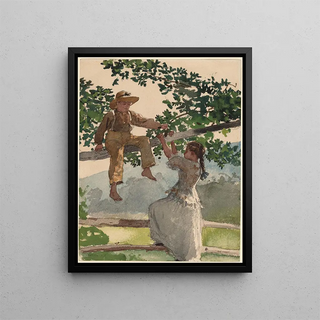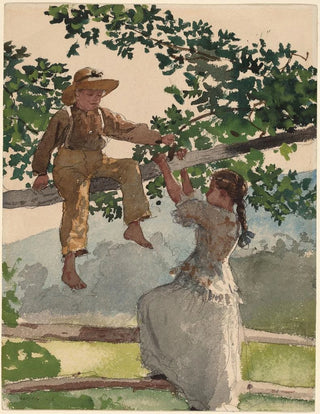Art print | On the fence - Winslow Homer Source: Reproduction | Sur la clôture - Winslow Homer


View from behind

Frame (optional)
In the world of art, some works transcend the mere frame to become windows into emotions and stories of extraordinary depth. "On the Fence" by Winslow Homer is one of these creations. This painting, imbued with an atmosphere that is both peaceful and tense, immerses us in a scene of 19th-century American daily life. The composition, where the figures seem frozen in a moment of contemplation, evokes an intimate connection with nature and the passage of time. The piece invites the viewer to question the meaning of the moment, to reflect on the choices and paths that life offers us.
Style and uniqueness of the work
Winslow Homer's style is distinguished by its realistic approach and its ability to capture light and shadow with remarkable precision. In "On the Fence," the artist uses a palette of soft, natural colors, which enhances the feeling of serenity and nostalgia. The figures, although static, convey a certain dynamism through their posture and the subtle interaction between them. The fence itself, a central element of the composition, symbolizes both separation and connection, a passage between two worlds. Homer's play with textures, from the raw wood of the fence to the clothing of the figures, demonstrates his skill in rendering every detail lively. This work, while rooted in tangible reality, also invites reflection on universal themes such as solitude, hope, and the passage of time.
The artist and his influence
Winslow Homer, an iconic figure of American art, captured the essence of his era through his works. Born in 1836, he was initially an illustrator before turning to painting, where he developed a unique style combining realism and impressionism. His fascination with nature and daily life is reflected in his paintings, often depicting maritime scenes and rural landscapes. Homer's influence on American art is undeniable, inspiring many artists who followed, notably through his bold use of color and his ability to convey deep emotions. "On the Fence" is part of

Matte finish

View from behind

Frame (optional)
In the world of art, some works transcend the mere frame to become windows into emotions and stories of extraordinary depth. "On the Fence" by Winslow Homer is one of these creations. This painting, imbued with an atmosphere that is both peaceful and tense, immerses us in a scene of 19th-century American daily life. The composition, where the figures seem frozen in a moment of contemplation, evokes an intimate connection with nature and the passage of time. The piece invites the viewer to question the meaning of the moment, to reflect on the choices and paths that life offers us.
Style and uniqueness of the work
Winslow Homer's style is distinguished by its realistic approach and its ability to capture light and shadow with remarkable precision. In "On the Fence," the artist uses a palette of soft, natural colors, which enhances the feeling of serenity and nostalgia. The figures, although static, convey a certain dynamism through their posture and the subtle interaction between them. The fence itself, a central element of the composition, symbolizes both separation and connection, a passage between two worlds. Homer's play with textures, from the raw wood of the fence to the clothing of the figures, demonstrates his skill in rendering every detail lively. This work, while rooted in tangible reality, also invites reflection on universal themes such as solitude, hope, and the passage of time.
The artist and his influence
Winslow Homer, an iconic figure of American art, captured the essence of his era through his works. Born in 1836, he was initially an illustrator before turning to painting, where he developed a unique style combining realism and impressionism. His fascination with nature and daily life is reflected in his paintings, often depicting maritime scenes and rural landscapes. Homer's influence on American art is undeniable, inspiring many artists who followed, notably through his bold use of color and his ability to convey deep emotions. "On the Fence" is part of






